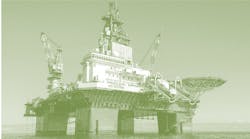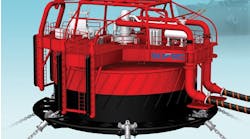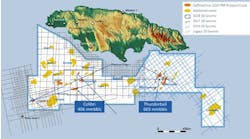OTC 2016: BSEE, Coast Guard officials discuss safety culture, regulations
Bruce Beaubouef
HOUSTON – The offshore oil and gas industry needs to make greater strides toward a safety culture that includes all companies that operate on the outer continental shelf, and those companies need to participate in an industry-wide data sharing system.
That was the message offered byBrian Salerno, Director of the US Bureau of Safety and Environmental Enforcement (BSEE), and Rear Admiral Paul F. Thomas, Assistant Commandant for Prevention Policy, US Coast Guard, in a panel discussion moderated by Charlie Williams, Executive Director of the Center for Offshore Safety (COS) held on Thursday at this year’s Offshore Technology Conference in Houston. Salerno and Thomas spoke at length on matters relating to safety, safety management, and future regulatory activity before opening up the sessions to questions from the audience.
Salerno said that going forward, safety management will be the biggest area for improvement for the offshore oil and gas industry. What the industry needs, he observed, is a broader safety culture that includes operators, contractors, suppliers, vendors, and all of the various parts of the offshore oil and gas community.
The BSEE director recognized that it is inherently difficult to quantify and measure a safety culture, but he noted that there are indicators that the industry can use. “Safety culture is important,” he said, “but how do we define it?”
To develop these indicators, Salerno said that companies need to share safety data, and make greater use of that data. For this to happen, “the leadership needs to be committed, and the workers have to be involved.” He noted that the COS is working to develop safety management indicators that can be used to measure safety management.
Safety culture should not only exist within companies, but throughout the entire industry – and also within the relevant government agencies, he conceded. Salerno noted that the BSEE is working with SPE and the COS on a data-sharing system that the entire industry can use and benefit from.
The goal, he said, “is to move beyond company self analysis, and take data sharing to an industry-wide level.” He recognized that “regulatory consistency on the part of the BSEE and the Coast Guard” would be an important part of this process.
Salerno also emphasized the need for a structural focus on risk. “It all ties into SEMS, and the BSEE, the COS, and the Coast Guard are all working together to raise the bar,” he commented. The federal safety and emergency management system regulations passed in the wake of Macondo are the mechanism that should be used to raise that bar, he said.
Thomas recognized that these were challenging times for the industry. But he said that “despite the downturn, we are still focused on safety on the OCS.” He admitted that the slowdown inGulf of Mexico E&P activity had enabled the Coast Guard to “catch up” in terms of regulatory processes and systems.
He also outlined four key focus areas that the Coast Guard has been working on to improve safety in the offshore oil and gas arena.
One key focus area has been the joint Coast Guard/BSEE effort to develop regulatory complementarity, and avoid regulatory contradictions and duplication. Sharing data is a key part of this, Thomas said.
Well intervention has been a second focus area. Thomas said that the Coast Guard has been working with the Offshore Operator’s Committee (OOC) and other industry groups to determine which risk mitigation systems are best, and which types of vessels are best suited to undertake these operations.
Cyber risk management has been a third focus area. “There is a real vulnerability here,” Thomas observed. “Cyber risks need to be managed like physical risks.” He noted that “drilling contractors have been doing a good job” on this front.
Echoing Salerno’s themes, Thomas pointed out that the Coast Guard’s fourth focus area has been safety management systems and safety culture. He noted that some companies had yet to implement safety management systems, but warned that “this needs to change.” He observed that most of the major offshore projects involve groups of operators, but he cited the old saying that “a chain is only as strong as its weakest link.”
With regard to theongoing BSEE/Coast Guard cooperative efforts, Salerno noted that the two agencies meet on a quarterly basis to coordinate joint training efforts and investigations, and work upon environmental preparedness strategies. “Our senior staffs are very well integrated, so we can see the whole picture,” Thomas added.
After the presentations, an audience member asked Salerno whether there would be a SEMS III regulation. “TheSEMS regulation needs to move beyond its current state,” Salerno replied, but he added that “there would be no new regulations for now.” He noted that the BSEE is working with the API on this front, with more emphasis on process management and cyber security.
Thomas added that the Coast Guard is currently in the rule-making process with regard to safety management systems, but added that he could not comment “too much” because of the ongoing effort. He did note that some well intervention vessels were not currently covered by safety management systems, and commented that “we need to look at this. It remains a high priority for us.”
Another audience member wondered how the BSEE and the Coast Guard divided their regulatory duties with regard to offshore operations – “who regulates what and how?” Salerno replied that “if there is a well, it’s BSEE.” But he added that his agency does coordinate with other relevant regulatory agencies.
Another attendee asked whether the industry needed to collaborate more on data sharing. Salerno reaffirmed his earlier point: “It is vitally important to make advances on this front. We can raise the bar on safety by improving processes and barrier management.” He added: “It’s great when companies implement these systems within, but it needs to spread across the entire industry.”
Salerno acknowledged that sharing data could possibly leave companies vulnerable to competitive disadvantage. For this reason, he recognized the necessity of identifying key data points and protecting sources, but he added that “we need to share that data.” If an incident takes place, it affects the entire industry, he pointed out. “What’s bad for one company is bad for the whole industry,” Salerno said. He pointed to the recent issue of faulty connector bolts that has raised safety and environmental concerns on some offshore structures. “Sharing info on can be vital on this type of issue.”
Data sharing will help build the needed safety culture, Thomas pointed out. But he also observed that “safety culture comes from within. It cannot be imposed by regulations.”
“You can’t mandate a safety culture,” Salerno confirmed. “But you can incentivize it.” It is for this reason that regulatory agencies need to “stress the benefits of data sharing to the industry.”
05/09/2016


